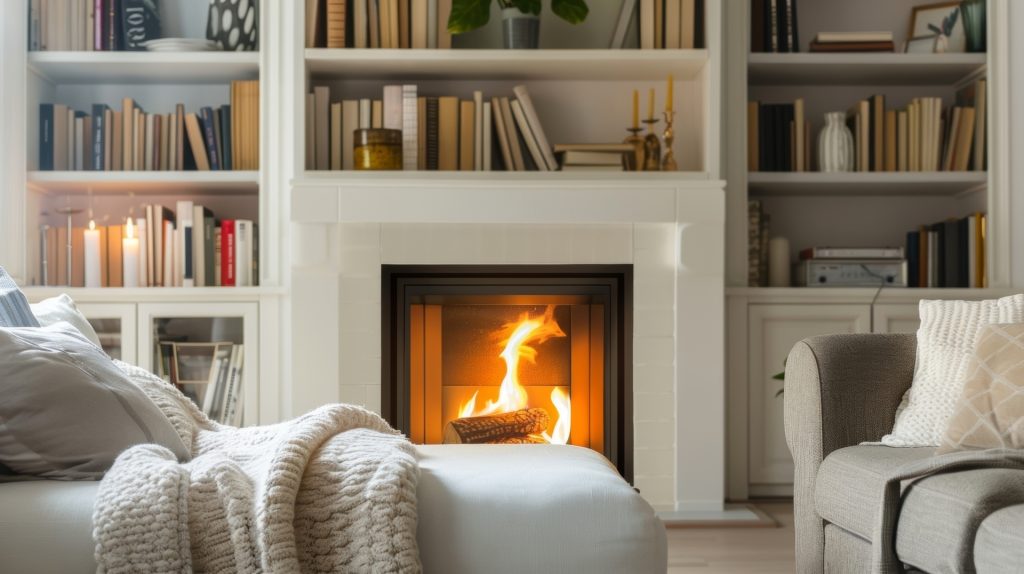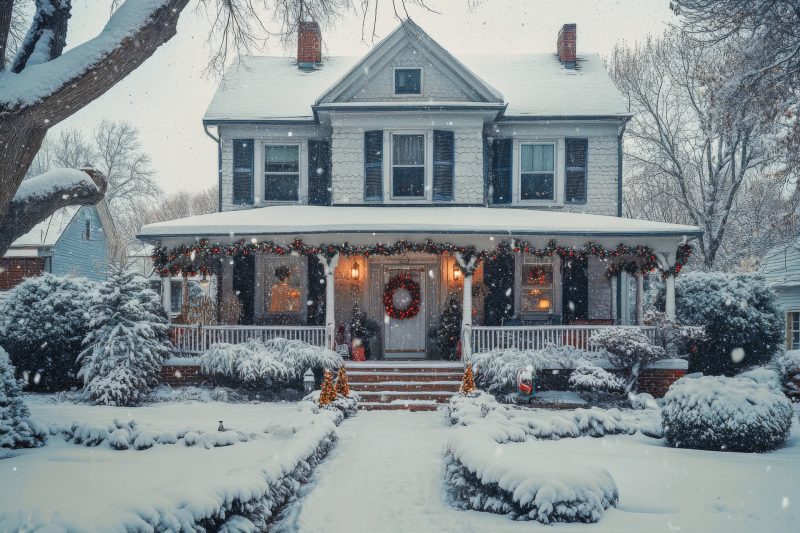Taking steps to winterize your Denver area home can not only ensure your family’s comfort throughout the cold weather season, but it can also save you money and increase your energy efficiency throughout the season. Colorado can receive extreme temps and snowfall, which makes winterization a necessary task for area homeowners. After all, it’s always better to be prepared before an emergency! Not only will these tips for winterizing your home make for a more comfortable space to live in, but they may also increase the value of your home.
Service Your HVAC System
Regular maintenance of your heating, ventilation, and air conditioning is a vital step before winter sets in. A large percentage of Americans don’t change their air filters on a monthly basis. Replacing these filters can help ensure efficient airflow and prevent dust buildup. If you haven’t already, go ahead and replace yours and have a few extras on standby so you don’t have to think about it next month. Before winter sets in, it’s also recommended to schedule a professional HVAC inspection and tune-up to make sure your system is working efficiently all winter long. After all, if something fails during a snowstorm — you can expect longer wait times and a potentially chilly household before a pro can get out to your property. It’s always cheaper and easier to maintain a working system by tuning it, versus replacing an entire unit due to neglect.
Clean & Inspect Your Fireplace

The best time to have your fireplace and chimney inspected is in the fall. This way, you’ll be prepared to light up a cozy fire when the temperatures drop. Ensuring that your unit operates safely and efficiently throughout the winter requires a couple of steps, including scheduling a professional to come out before the freezing weather rolls on in. Winter is the busiest time for fireplace technicians, so if you leave maintenance off — you may be waiting for a while. Prices may also increase during the winter in line with the increased demand. It’s recommended that you have your chimney inspected once a year, so add this routine annual preventative maintenance to your list of chores as you begin the process of winterizing your Denver area home. Not only is an inspection a great way to avoid the build up of creosote, thus decreasing your risk of a chimney fire, but it can also improve heating efficiency and ensure proper ventilation. A clogged chimney can cause smoke, ash, and even carbon monoxide to become trapped in your home.
Reseal Your Outdoor Deck
If you have a deck that you’re particularly proud of, you won’t want to skimp on preparing it for winter! This involves sealing the deck before the onset of freezing winter weather, which can cause moisture buildup during the freeze and thaw cycles. Winterizing your deck helps to prevent water from getting into cracks in the structure, which can freeze and expand the cracks or even create new splinters. Another added benefit of winterizing your deck is that it’ll be a breeze to clean in the springtime when you’re ready to enjoy your patio space once again. Preparing your deck for winter would typically start in the warmer months, such as late summer or early fall before the weather gets cold. Warm weather is often a requirement for using materials like cleaners and sealers. Once you’ve cleaned your deck, apply a clear sealer to keep the natural wood tone or use a stain and sealer to add color and protection. Allow the sealer to dry and apply a second coat if the instructions prompt you to do so.
Cover Your Patio Furniture
There are a few ways that you can go about winterizing your outdoor furniture in your Denver home. Many people find themselves staying indoors more during the colder months, therefore using their outdoor furniture less. In this case, go ahead and wash off the furniture to remove debris, let it dry, and then cover it up until the warmer days of spring return. If you want to use the furniture throughout the winter and kick back with a fire outside, you can still apply a protective coating, such as a sealant, to any wood furniture. This is a similar process to protecting your deck and it can keep the wood from cracking. In some cases, you may wish to store the furniture away altogether. This is often the route homeowners take if they plan to be away for the winter months. Take advantage of your garage, basement, or even a protected shed to keep your patio furniture as good as new.
Reverse Your Ceiling Fans

During the winter, make sure to “reverse” your fans. This means that the fan begins rotating clockwise, which pushes warm air that accumulates near the ceiling down towards the floor. This helps to distribute heat more evenly throughout the room. This is also known as setting fans on “winter mode,” which creates a gentle updraft and eliminates cold spots. For optimal winter fan usage, run the fan at a low speed to avoid creating an uncomfortable draft. You may find that using your fans in winter mode can make you feel warmer, which may even allow you to lower your thermostat by a few degrees and reduce your utility bills by 15% or more!
Check for Drafts in Your Windows
Leaky windows can be a major source of heat loss during the winter. This is an easy home maintenance task that only takes a few minutes to complete per window. The U.S. Department of Energy recommends building a pressurization test, such as lighting an incense stick or a candle and using it to visually identify if there is air movement around the window’s edges. If the smoke wavers or is blown out completely, this indicates that there’s a draft. Another way to do this is to use a damp hand to locate leaks, as the drafty areas will cause a cold sensation on your hand. Another thing to keep an eye out for while you’re inspecting your windows is damaged weatherstripping, cracked or loose caulking, and loose window hardware. Replacing weatherstripping, reapplying caulk, and tightening loose hardware should be added to your to-do list as you winterize your home if you’ve found a drafty window or two! Other areas to check for leaks and drafts include mail chutes, electrical outlets, door frames, and the insulation around your fireplace.
Protect Your Plumbing
Nobody wants to wake up in the morning to find that their plumping has frozen after temperatures dropped overnight. A few ways to avoid such a hassle include insulating your pipes by wrapping them with a foam insulation sleeve or heat tape, especially in areas where the pipe is left exposed to the elements. Other tips to keep in mind to avoid your plumbing from freezing include dripping your faucets when temperatures are expected to drop well below freezing, opening the cabinet doors to allow warm air to circulate, and keeping the thermostat set at least 55 degrees (even if you’re planning on being away for an extended period). Pipes are prone to freeze when temps drop below 20 degrees Fahrenheit and the longer the weather remains below 32 degrees, the more likely pipes are to freeze.
Upgrade to a Programmable Thermostat

If your home isn’t already equipped with a programmable thermostat, this is a great investment to make for the winter season. These thermostats allow you to set different interior temperatures for various times of the day. Not only does this keep your living space comfortable when you arrive home, it can help you optimize your energy usage as well! You may save as much as 10% per year on heating and cooling costs by simply turning your thermostat back 7 to 10 degrees for 8 hours a day from its normal setting. Residents can set the temperature lower while they’re away at work and raise it when they’re at home. The benefit doesn’t just end during the winter, either! The programmable nature of these thermostats can help you save on energy during the summer as well so you’re not blasting the air conditioning all day while you’re out exploring the mountains or visiting a new local brewery in Denver!
Inspect Your Roof and Gutters
When it comes to winterizing your home, you can’t forget about the exterior components! In fact, the roof and gutters are arguably one of the most important tasks. Clearing your guts and downspouts of leaves and debris before the cold weather rolls in can help prevent ice dams, which can potentially lead to expensive roof leaks. Ice dams occur when heavy snow buildup melts during the day before refreezing overnight when temperatures drop. If these dams go unnoticed for too long, they can do significant damage. If you have tree branches near your home, you may want to consider giving them a trim. A heavy snowfall can lead to heavy accumulation, potentially breaking off the weaker branches and causing damage to your home or vehicles. If you don’t feel comfortable inspecting your roof, hire a professional to check for loose, missing, or damaged shingles.
Stock Up on Winter Essentials
If you’ve recently moved to Denver and this will be your first winter in the area, you may not know what “winter essentials” you should even be stocking up on. When living in a colder climate or an area that may receive snow throughout the season, it’s important to prepare for such storms and icy conditions so you can avoid rushing in an emergency. Living in Denver during the winter may require you to buy some salt or sand for driveways and sidewalks. Many residents also opt to keep snow shovels, roof rakes, and windshield de-icers handy so they can clear a path and prepare their vehicle to make the chilly commute to the office or to the grocery store. Having an emergency kit at the ready is never a bad idea either, whether you live in Denver or anywhere else. In your kit, you’ll want flashlights, extra batteries, blankets, and bottled water. It’s also recommended that drivers keep a similar emergency supply kit in their vehicles, stocked with a tow rope, warm clothing, snacks, a cell phone charger, a first aid kit, and more.
Test Your Smoke Detectors

As the temperatures begin to drop, you’re likely to kick on your heating system or light up the fireplace to enjoy a cozy morning at home. Before you get warm and toasty, make sure that you’ve checked the smoke and carbon monoxide detectors throughout your home. The winter months see a spike in carbon monoxide poisoning and house fires. Replace batteries as needed so you can rest assured that you’re safe. If your home doesn’t have detectors near bedrooms or on each level of the home, go ahead and install them. Detectors should also be replaced if they’re older than 10 years old. Ideally, smoke detector batteries should be changed at least once a year. A good way to remember this task is to do it when the clocks change in the fall. If you’ve noticed a chirping sound, this is typically an indicator that the detector is low on battery.
Stay Warm This Winter in Denver!
Now that you know how to properly winterize your Denver home, we hope you stay safe, warm, and comfortable throughout the season. With spring around the corner, you’ll want to start thinking about your spring cleaning list next!
